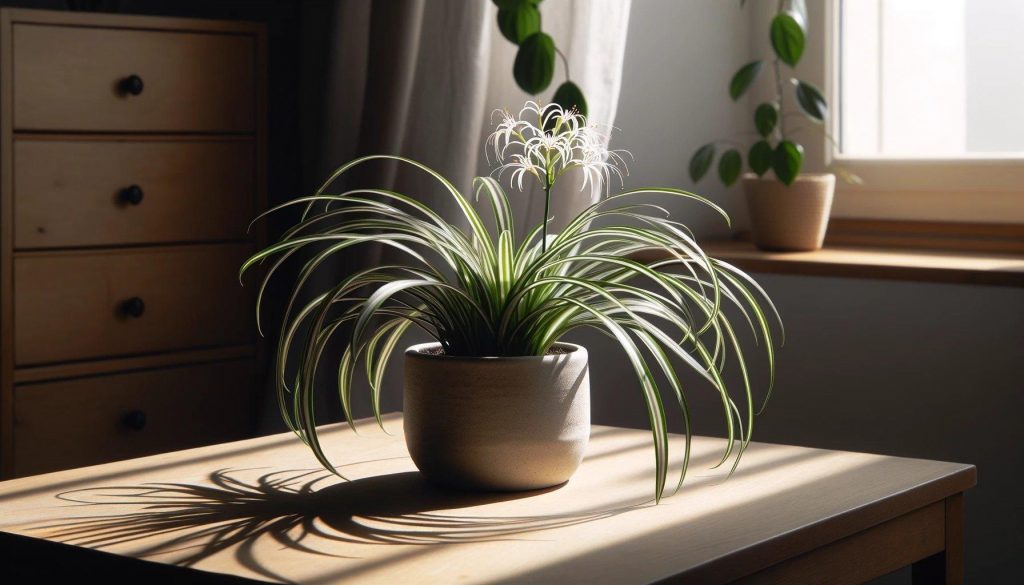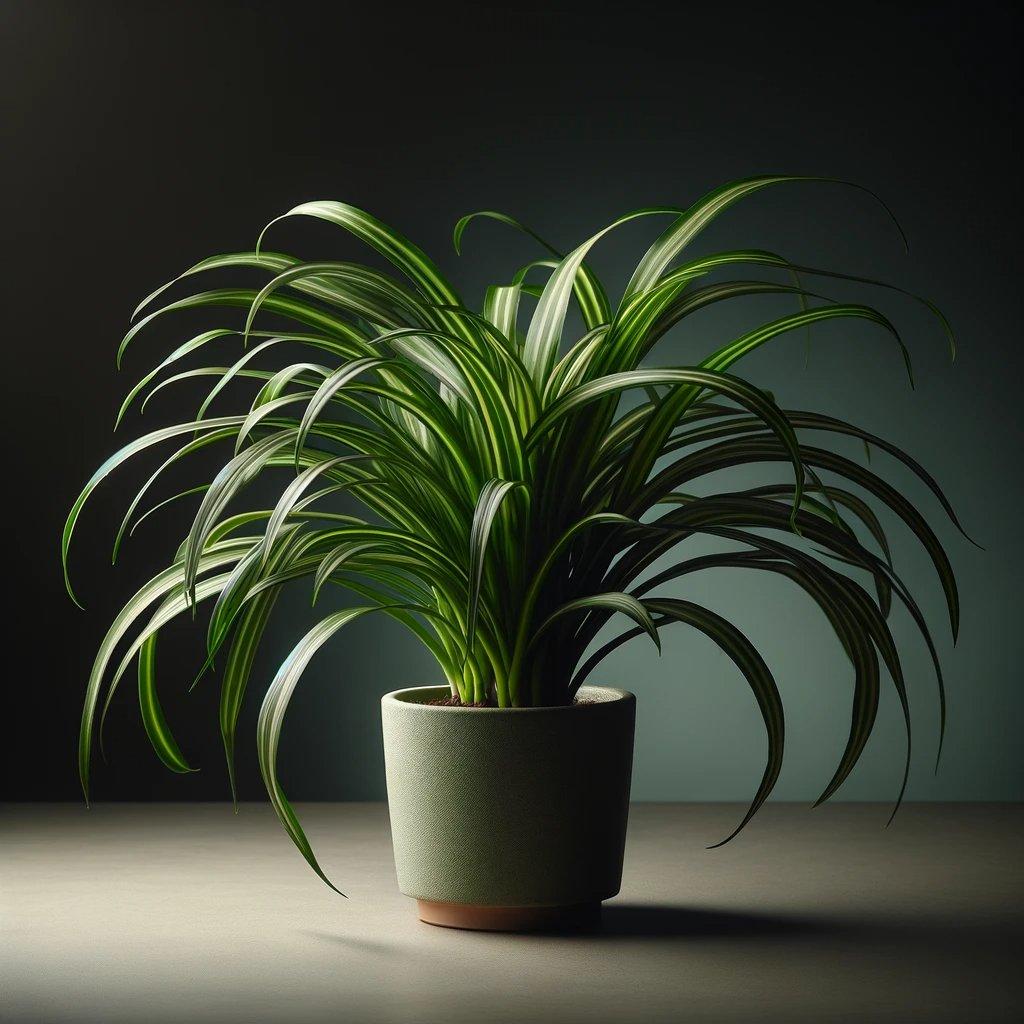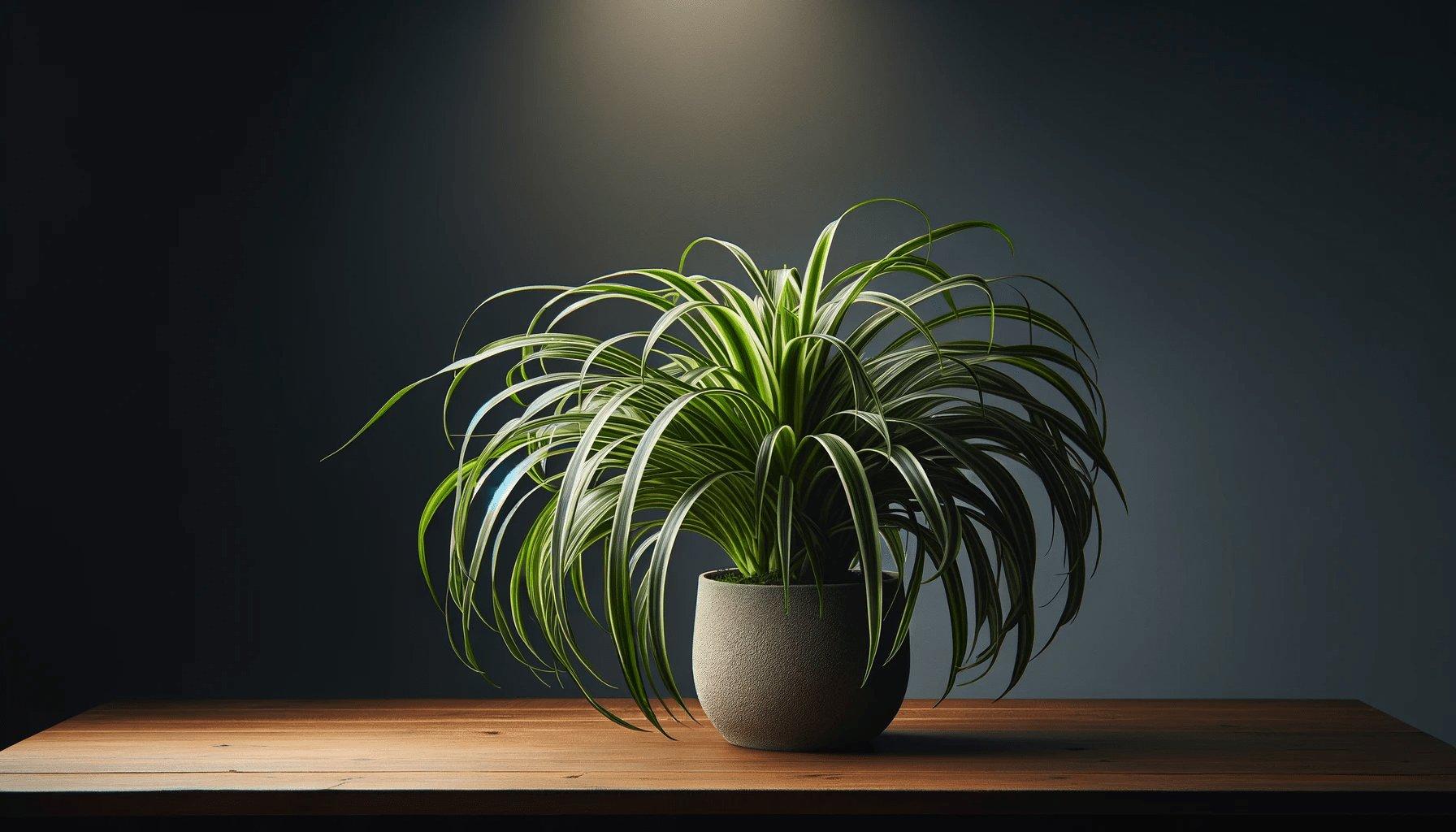The Spider Plant, scientifically known as Chlorophytum comosum, is a perennial favorite among houseplant enthusiasts. Renowned for its ease of care, rapid growth, and charming spiderette offshoots, this plant adds a lively touch to any indoor space. In this detailed guide, we’ll cover everything you need to know about growing and nurturing Spider Plants.
Spider Plants, with their arching leaves and delightful spiderettes, are not only attractive but also effective at purifying indoor air. They are known for their resilience and adaptability, making them perfect for both novice and experienced plant owners.

Light Requirements for Thriving Spider Plants
Ideal Light Conditions
Spider Plants prefer bright, indirect light. While they can tolerate some degree of shade, too little light can lead to less vigorous growth.
Avoiding Direct Sunlight
Direct sunlight, especially in hot summer months, can scorch their leaves, causing brown tips and faded coloration. East or west-facing windows are typically ideal.
Watering: Finding the Perfect Balance
Watering Frequency
The key to watering Spider Plants is consistency. During their growth period in spring and summer, keep the soil evenly moist. However, it’s crucial to let the soil dry out slightly between waterings.
Winter Watering
In winter, reduce watering as growth slows down. Overwatering can cause root rot, a common issue in Spider Plants.
Ideal Environment for Spider Plants
Temperature and Humidity
Spider Plants thrive in temperatures between 60-75°F (15-24°C). They prefer a moderate humidity level and can benefit from occasional misting.
Air Circulation
Good air circulation is vital for keeping your Spider Plant healthy, helping to prevent pest infestations and diseases.
Growth Patterns and Characteristics
Rapid Growth
One of the most endearing features of the Spider Plant is its rapid growth rate and the production of spiderettes or plantlets.
Variegated Varieties
There are several varieties of Spider Plants, with some featuring variegated leaves with white stripes or edges, adding to their visual appeal.
Repotting Essentials
When to Repot
Spider Plants typically need to be repotted every 1-2 years. Signs that your plant needs repotting include crowded roots and stagnant growth.
Repotting Steps
- Select a pot that’s slightly larger than the current one and has good drainage.
- Use a well-draining potting mix to provide the necessary nutrients and aeration.
- Carefully transfer the plant, ensuring not to damage the roots.
Propagating Your Spider Plant
Using Spiderettes
Propagation is simple and rewarding with Spider Plants. You can propagate by planting the spiderettes directly in the soil or rooting them in water first.
Division
Another method is division during repotting, where you separate the mother plant into smaller plants, each with its root system.
Understanding Spider Plant Toxicity
Safe for Pets and Children
One of the advantages of Spider Plants is their non-toxicity. They are safe to keep in homes with pets and children, unlike many other houseplants.

Pros and Cons of Spider Plants (Chlorophytum Comosum)
| Pros of Spider Plants | Cons of Spider Plants |
|---|---|
| Air Purifying: Spider Plants are known for their ability to purify indoor air, removing pollutants like formaldehyde and xylene. | Sensitive to Fluoride: Spider Plants can be sensitive to fluoride in tap water, leading to brown leaf tips. |
| Non-Toxic to Pets and Children: These plants are safe for homes with pets and children, making them an ideal choice for many households. | Light Requirements: They require bright, indirect light to thrive; too little light can result in leggy growth and reduced variegation. |
| Easy to Propagate: Spider Plants readily produce spiderettes, which can be easily rooted to grow new plants. | Overgrowth: They can grow rapidly and might require frequent repotting or pruning to manage their size. |
| Low Maintenance: They are resilient and can tolerate a certain degree of neglect, making them suitable for busy or novice plant owners. | Requires Regular Watering in Growth Season: During spring and summer, they need consistent watering, which can be a bit demanding for some plant owners. |
| Adaptable to Various Environments: Spider Plants can thrive in a range of temperatures and humidity levels, adapting well to typical indoor conditions. | Risk of Root Rot: Overwatering can lead to root rot, so proper watering practices are crucial. |
| Aesthetic Appeal: With their arching green leaves and variegated varieties, Spider Plants add visual interest to any space. | Pest Attraction: Like many houseplants, they can attract pests like spider mites if not properly cared for. |
In summary, Spider Plants are great for purifying air, are easy to care for, and are safe for pets and children. They do need specific amounts of water and light, and without proper maintenance, they might overgrow or attract pests. Despite these small challenges, their versatility and attractiveness make them a favorite among indoor gardening enthusiasts.
Frequently Asked Questions About Spider Plant Care
Q1: How do I grow a Spider Plant indoors?
A1: Growing a Spider Plant indoors is easy. Place it in a spot with bright, indirect light, use well-draining potting soil, and water when the top inch of soil is dry. Spider Plants can also thrive in a range of indoor temperatures and humidity levels.
Q2: What type of pot should I use for a Spider Plant?
A2: Spider Plants do well in standard pots with drainage holes. They can also be grown in hanging baskets, which allow their spiderettes to dangle attractively.
Q3: Can Spider Plants be grown outdoors?
A3: Yes, Spider Plants can be grown outdoors in mild climates. However, they should be brought indoors if temperatures drop significantly.
Q4: How often should I water a Spider Plant?
A4: Water Spider Plants when the top inch of soil feels dry. They like even moisture, but be careful not to overwater, as this can cause root rot.
Q5: Do Spider Plants need a lot of sunlight?
A5: Spider Plants prefer bright, indirect light. Direct sunlight can scorch the leaves, especially the variegated types. They can tolerate lower light levels but may not grow as vigorously.
Q6: When should I fertilize my Spider Plant?
A6: Fertilize your Spider Plant regularly during the growing season (spring and summer) with a balanced houseplant fertilizer. Reduce feeding in the fall and winter when growth slows.
Q7: Are Spider Plants easy to propagate?
A7: Yes, it’s easy to propagate Spider Plants. You can start new plants by potting the baby spider plants, known as spiderettes, once they develop roots from the mother plant.
Q8: Why does my Spider Plant have brown leaf tips?
A8: Brown leaf tips in Spider Plants can result from fluoride in tap water, dry soil, or low humidity. To prevent tip burn, try using distilled or rainwater.
Q9: What are the different types of Spider Plants?
A9: There are several cultivars of Spider Plants. The most common are the variegated types with green and white striped leaves, but there are also solid green varieties.
Q10: Do Chlorophytum comosum produce flowers?
A10: Yes, mature Chlorophytum comosum can produce small, white star-shaped flowers on long flower stalks. However, they are primarily grown for their attractive foliage.
Q11: How big can Spider Plants get?
A11: Spider Plants can grow quite large, with the main plant reaching several feet in width. The spiderettes or baby plants dangle from the parent plant, adding to its size.
Q12: Can Spider Plants improve indoor air quality?
A12: Yes, Spider Plants are excellent for improving indoor air quality. They are known to remove common household toxins from the air, making them a healthy addition to your home.
Q13: Are there any common diseases that affect Spider Plants?
A13: Spider Plants are generally hardy, but they can be susceptible to common houseplant diseases like root rot, especially if overwatered. They can also attract pests like spider mites.
Q14: How often should I repot a Chlorophytum comosum?
A14: Repot Chlorophytum comosum every 1-2 years or when the roots have outgrown the pot. Use fresh potting soil and a slightly larger pot to encourage continued growth.
Q15: How do I care for the spiderettes on my Spider Plant?
A15: To care for spiderettes, you can leave them attached to the mother plant, where they will continue to grow, or snip them off and pot them separately once they develop fleshy roots, to start new plants.
Introduction
Nicki Mann, based in Portland, Oregon, is a good writer and houseplant enthusiast. With her background in environmental science, Nicki specializes in indoor gardening, focusing on sustainable and organic practices.
Experience
Her interest in houseplants began in her mid-twenties, leading to a career writing articles about indoor plant care and eco-friendly gardening for various websites.
Education
Nicki holds a Bachelor of Science in Environmental Studies from the University of Oregon, which underpins her approach to indoor gardening. She continually enhances her knowledge through horticulture and environmental sustainability workshops.
Personal Life
Nicki, an avid nature lover, enjoys exploring the Pacific Northwest's trails. She's active in community gardening and lives with her two rescue cats, who share her interest in her growing collection of houseplants.


